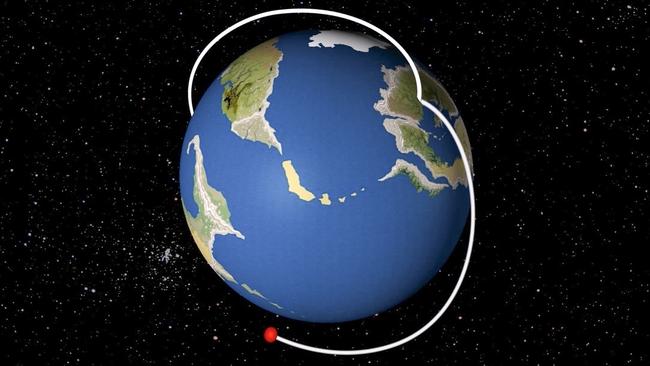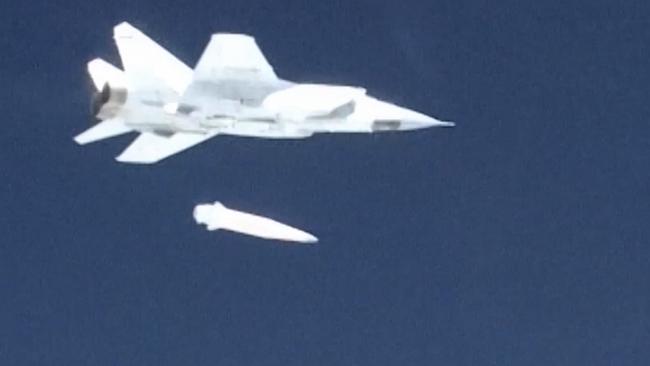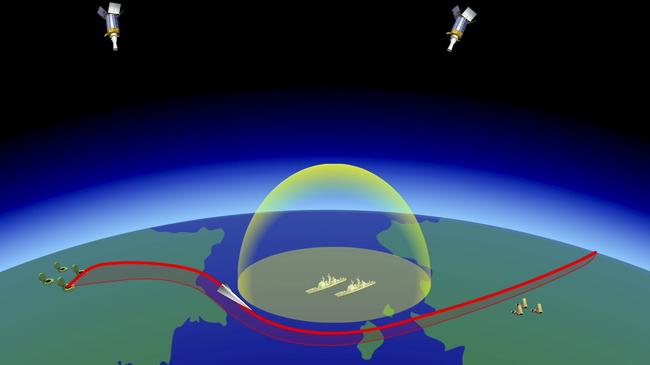These are the weapons Putin wants you to be afraid of
TWO years ago, scientists were baffled by a discovery over Alaska. But based on Putin’s new threat, we may have an explanation.

IN AUGUST 2016, scientists made a mysterious discovery in the sky over Alaska’s Aleutian Islands.
While sampling the air, a research plane for the National Oceanic and Atmospheric Administration (NOAA) discovered an unusual particle containing a small amount of radioactive substance.
The fragment was harmless and minuscule — just 580 nanometres (a billionth of a metre) of enriched uranium — but it was enough to set off alarm bells.
Where did this unnatural substance come from? What did it signify? Experts speculated on everything from Chernobyl and Fukushima to nuclear weapon tests in North Korea.
READ MORE: Mysterious uranium particle detected above Alaska
But judging by Vladimir Putin’s State of the Union address, we may have a new suspect in the mix.
Mr Putin claimed Russia has developed various hi-tech weapons capable of rendering NATO’s US-led missile defence system useless.
Among these is a cruise missile he says can initiate a nuclear strike with boundless range, with no restrictions on fuel source. All of this came with a warning for the West: “This is not a bluff.”
Mr Putin said the weapons were not designed to attack any other country, but that they would be used if Russia were to come under nuclear attack. He claimed the tests were a response to US military build-up and growing NATO presence on Russia’s borders.
Of the weapons listed below, the first may well explain that mysterious particle that’s been baffling scientists.
THE GLOBAL-RANGE NUCLEAR CRUISE MISSILE
Experts have described the global nuclear missile as the most eye-catching of Mr Putin’s announced weapons.
It features a compact, nuclear-powered engine, with alleged stealth capabilities, making it difficult to detect, and high manoeuvrability to bypass an enemy’s defences.
It also could explain the strange particle discovered by the NOAA.

As The Washington Post points out, the US began developing a similar mechanism during the Cold War, using the codename Project Pluto.
This mechanism used a “ramjet” engine, a light propulsion engine that allows for high-speed flight, heated with a small nuclear reactor. One feature of ramjet engines is that they can emit detectable radioactive particles.
“It strikes me that if Russia really did test a nuclear-powered cruise missile, and they have not figured out a way to keep it from spraying radioactive particles, there should be some atmospheric traces,” Reuters editor Gerry Doyle speculated.
This ties into the reports of radioactive particles detected above Alaska and Scandinavia, which researchers were at a loss to explain, and could suggest Russia was testing these missiles as far back as 2016.
The US confirmed it’s been aware of Russia’s developments for quite some time.
“These weapons that are discussed have been in development a long time,” said Pentagon spokeswoman Dana White. “We weren’t surprised by his statements.”
THE INTERCONTINENTAL UNDERWATER DRONE
Russia’s high-speed underwater drone is said to be 100 times smaller than a submarine.
It has an intercontinental range and can slam a nuclear warhead into both aircraft carriers and coastal facilities, Mr Putin claimed.
He described them as noiseless, unmanned submarines capable of operating at “very big” depth, with speeds several times quicker than the world’s fastest vessels and torpedoes in use today.
He went on to claim there are no means in the world to counter it now.
“There is no defence system that can cope with such subsurface vehicles that can be equipped with conventional or nuclear weapons, attacking coastal defences and infrastructure facilities.
THE RS-28 SARMAT BALLISTIC MISSILE
The Sarmat is an upgraded version of the Soviet-designed Voyevoda, the world’s heaviest intercontinental ballistic missile.
According to Mr Putin, it weighs 200,000kg, and is capable of flying over the North and South Poles to strike targets anywhere in the world.
He also said it accelerates faster than the Voyevoda, making it harder for an enemy to intercept, and could carry an array of warheads capable of dodging missile defences.

THE KINZHAL HYPERSONIC MISSILE
A hypersonic missile is capable of travelling at over five times the speed of sound. Both Russia and the US have been working to develop these.
Mr Putin said the Russian military has already put a hypersonic missile on duty.
The Kinzhal is said to be capable of travelling at 10-times the speed of sound, with a range of more than 2000km. It can also carry a nuclear or conventional warhead.
A video that accompanied his statement featured a MiG-31 fighter jet carrying a bulky missile under its fuselage and then launching it during a test flight. A computer animation showed the missile hitting a group of navy ships.

THE AVANGARD HYPERSONIC VEHICLE
The Avangard, which has been in the works for almost 15 years, is best used to conduct sharp manoeuvres to avoid missile defences.
Mr Putin announced that Russia has completed tests of this, and put it into serial production.
He also said the missile has an intercontinental range, and can fly at up to 20 times the speed of sound.

LASER WEAPONS
Mr Putin announced that Russia had achieved “significant results” with its laser weapon designs, which would significantly boost Russia’s military capability.
— With AP



